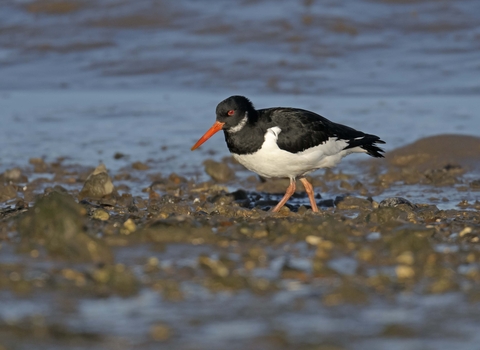
©James Rodgerson

©Chris Gomersall/2020VISION
Oystercatcher
The loud 'peep-ing' call of an oystercatcher is a recognisable and familiar sound of the seashore. Look out for it hunting on rocky and muddy shores for shellfish to eat. It can also be spotted on some inland waterbodies where it has started to breed.
Scientific name
Haematopus ostralegusWhen to see
January to DecemberSpecies information
Category
Statistics
Length: 40-45cmWingspan: 83cm
Weight: 540g
Average lifespan: 12 years
Classified in the UK as Amber under the Birds of Conservation Concern 5: the Red List for Birds (2021). Listed as Near Threatened on the global IUCN Red List of Threatened Species.
About
The oystercatcher is very noisy wading bird with a loud 'peep-ing' call. On the coast, it specialises in eating shellfish, particularly cockles and mussels, which it either prises or hammers open with its strong, flattened bill. Originally a coastal species, the oystercatcher has moved further inland over the last 50 years to breed on waterways and lakes. Most UK birds still spend their winters by the sea, however, and are joined by birds from Norway and Iceland.How to identify
The oystercatcher has a black head, back and wings, and a white underside. It has a long, red bill and pinky-red legs.Distribution
Widespread around the coast, with large wintering numbers at major estuaries. Also nests inland on flooded gravel pits and large rivers.In our area
These distinctive birds can often be seen on the rocky beaches of the River Severn outside Ironbridge and nest in wet meadows and on stony islands at Wood Lane nature reserve.
Did you know?
There are 12 species of oystercatcher in the world, all of which look very similar, being either pied or plain black, with a red bill and pink legs. A further species of oystercatcher became extinct in the 20th century.Watch
Oystercatcher (https://vimeo.com/447523534)
Oystercatcher by John Bridges
These distinctive birds can often be seen on the rocky beaches of the River Severn outside Ironbridge and nest in wet meadows and on stony islands at Wood Lane nature reserve.

